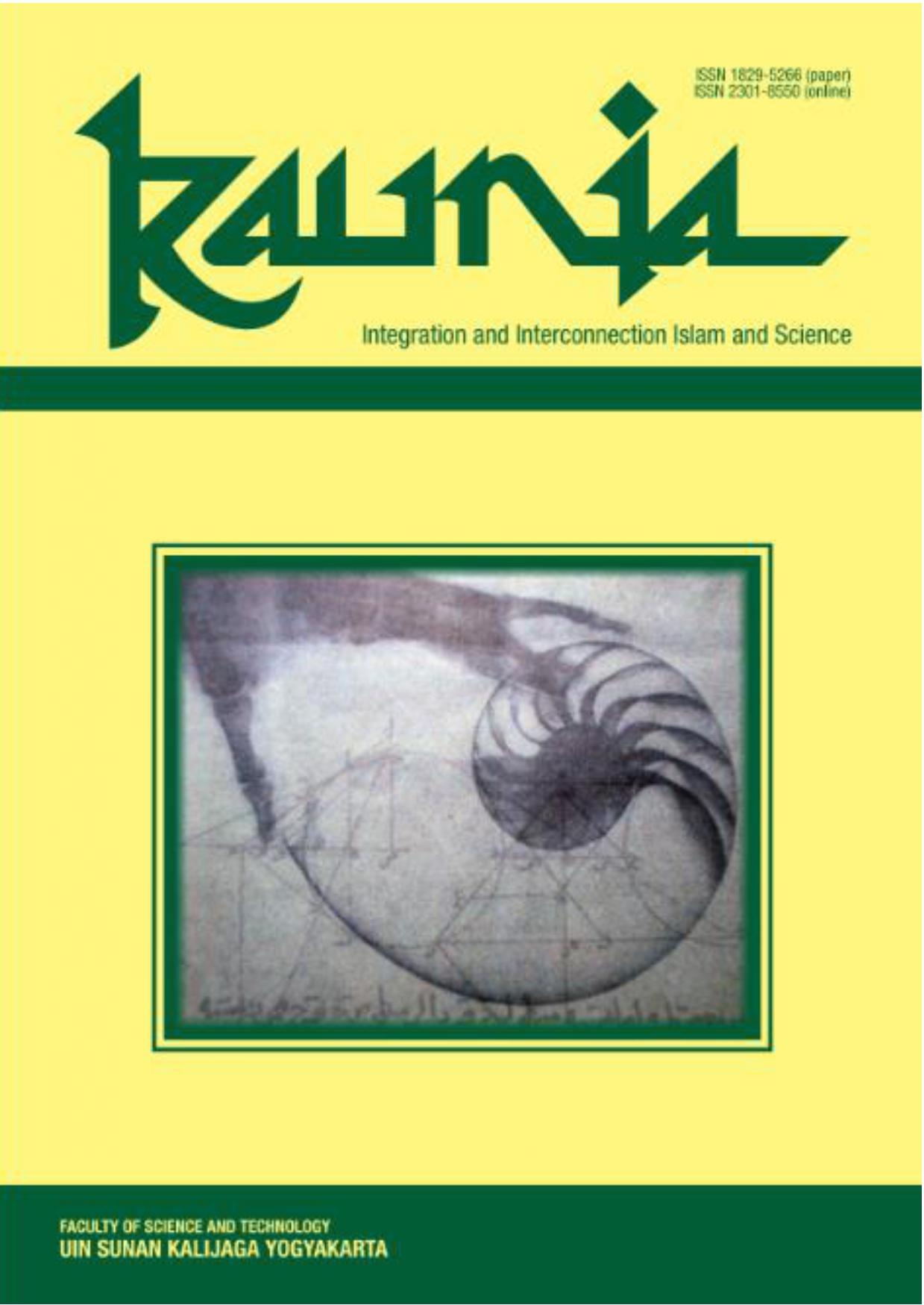Adsorption and Desorption Metal Cu (II) using Zeolite Synthetic by Bottom Ash Coal Modified Dithizone
DOI:
https://doi.org/10.14421/kaunia.3706Keywords:
bicarbonate, borehole water, chloride, pH, semi-arid, water supply, well waterAbstract
Zeolite synthetic and zeolite modified dithizone has been succesfully created by hydrotermal method. The aim of this research is to know the characteristics of zeolite synthetic and zeolite modified dithizone and to know capacity of adsorption and desorption. The effect of various variables, such as pH, concentration of Cu (II), contact time and temperature was investigated using batch process, characterization zeolite modified dithizone and zeolite synthetic using XRD, XRF, FTIR and GSA. The result of characterization bottom ash coal by hydrotermal reaction using XRF, be discovered composition Si as many 82,01% and Al 8,54%. product of melting hydrothermally indicate a specific zeolite IR absorption at a wavelength of 300-1250 cm-1. The result XRD showed that be found zeolite-X, zeolite-A, zeolite sodalite and difatogram of dithizone. Zeolite modified dithizone has been succesfully synthesized with a marked presence group of –NH and –SH by using FTIR. Zeolite modified dithizone surface area change from 160,262 m2/g to 69,609 m2/g. The best adsorption metal Cu(II) by zeolite synthetic is pH 7. Kinetics adsorption zeolite synthetic and zeolite modified dithizone follow kinetics of pseudo second orde, with R2 respectively 0,7378 and 0,8689, rate constant of pseudo second orde adsorption at zeolite synthetic is -0,017 g/mg.min-1 and zeolite modified dithizone -0,013 g/mg.min-1. Isotherm type for both of adsorbent follow Langmuir isotherm. Desorption of metal Cu(II) on zeolite modified dithizone and zeolite synthetic a lot off obtained using HCl at level 47,08% and 41,49% respectively.
References
Abdulhamid, A., Fakai, I. M., Sani, I., & Bello, F. I. (2013). “Evaluation of Ground Water Quality inKalambaina Community, Wamakko Local Government Sokoto State,”. Equity Journal of Science and Technology, 1(1):104–109.
Abubakar, A. A., Bashir, M. A., & Gambo, J. (2021). "Assessment of heavy metals in groundwater at New panteka Area of Kaduna, Nigeria". International Journal of Engineering Research and Technology, 10(9):604–607.
Aliyu, U., Yankuzo, M. H., & Ishaka, A. (2020). Determination of Selected Heavy Metals in Drinking Water Commonly Used in main campus Usmanu Danfodiyo University Sokoto. IOSR Journal of Applied Chemistry, 13(2):18–21.
Ardhiyanti, S. D. & Indrasari, S. D. (2020). A review on the physical, milling quality and physicochemical characteristic of Hipa 6 Jete and Hipa 7. Kaunia, 16(2):25–28. Isah, A.,
Saidu, I., Bello, K., & S. Garba, e. (2016). "Assessment of physicochemical properties of
groundwater sources from some selected areas in Sokoto metropolis, Nigeria". International Journal of Innovative Research and develoopment, 5(13):244–250.
Kasarawa, A. B., Salau, I. A., & Shehu, K. (2017). "Microbial quality of nonregistered table water sold in Sokoto Metropolis Northwestern Nigeria". World Journal of Advanced Research and Reviews, 6(03):007–011.
Rahamana, A. & Jolly, Y. N. (2021). “Assessment of physicochemical properties of water and their seasonal variation in an urban river in Bangladesh”. Water Science and Engineering, 14(2):139–148.
Sarkingobir, Y., Lawal, A. A., & Bello, Z. (2021). "COVID-19: causing increased pollution of waterbodies by plastics and consequent effects". Journal of water Pollution and Purification Research, 8(1):20–24, www.techjournals.in/index.php/joWPPR/index .
Sarkingobir, Y., Sambo, S., & U, T. (2020). Bacterial Quality Assessment of Drinking Water for Layer Chicken Managed Under Battery Cage and Deep Litter Systems from Sokoto Metropolis, Nigeria. Journal of Applied Sciences and Environmental Management, 24(1):97–103.
Tukura, B. W., Ayinya, M. I. G., Ibrahim, I. G., & Onche, E. U. (2014). Assessment of heavy metals in ground water from Nasarawa state, Middle belt, Nigeria”. American Chemical Science Journal, 4(6):798–812.
Uba, A., Liman, M. G., Yahaya, M., Abdullahi, M. I., & J, Y. A. (2016). "Physicochemical and heavy metals analysis of raw, treated water and sludge samples from a treatment plant in Sokoto, Nigeria". FUW Trends in Science and Technology, 2(1A):65–68.
Umar, A. I., Labbo, A M; Sumayya, A. A., Zainab, H. B., Sarkingobir, Y., Umar, A. I., & Dikko, M. (2021). “Effects of Some Goitrogens on Iodine distributions in Pipe-borne Water, Borehole Water and Well Water of Sokoto State, Nigeria”. International journal of Pure and Applied Science, 21(9):29–40.
Umar, A. I., Sarkingobir, Y., & Dikko, M. (2022). “Spectro-analytical research of selected heavy metals (Cu, Cd, Cr, and Pb) in four different single use plastics commonly in contact with food from Sokoto, Nigeria,” . Jurnal Teknokes, 15(1):76–80.
Wali, S. U., Gada, M. A., & Hamisu, I. C. (2022). "Evaluation of Shallow groundwater in rural Kebbi state Nigeria, using multivariate analysis: Implication for groundwater quality management". MOJ Ecology and Environmental Sciences, 7(3):65–75.
Yahaya, T., Doherty, V. F., Akinola, O. S., & Shamsudden, A. (2019). “Heavy metal profiles and microbiological counts of selected sachet water brands in Birnin Kebbi Metropolis, Nigeria”. Ife Journal of Science, 21(1):229–234.
Downloads
Published
How to Cite
Issue
Section
License
Copyright (c) 2022 Kaunia: Integration and Interconnection Islam and Science Journal

This work is licensed under a Creative Commons Attribution-NonCommercial-ShareAlike 4.0 International License.
All articles published in Kaunia are licensed under a Creative Commons Attribution-NonCommercial-ShareAlike 4.0 International license, with the copyright to these articles held by the journal. Anyone is free to read, download, copy, distribute, print, search, link to full text articles, or transform an article, in any medium or format, provided they do so non-commercially, give appropriate credit to Kaunia, and distribute any derivative work under the same (or equivalent) terms.
By submitting to Kaunia, authors agree to both the terms of the CC BY-NC-SA license and the automatic transfer of the copyright to their article if it is accepted.









